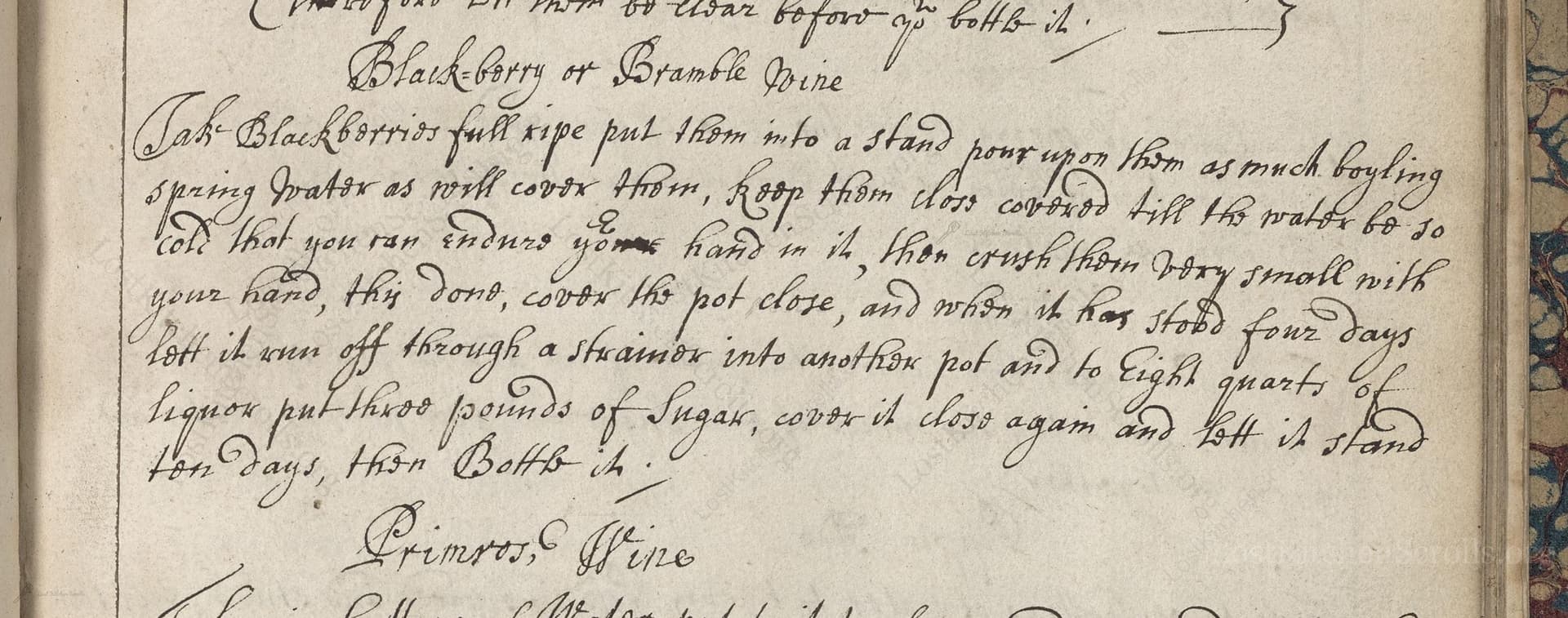Black-Berry Or Bramble Wine
From the treasured pages of Receipt book
Unknown Author

Black-Berry Or Bramble Wine
"Take Black berrys full ripe put them into a stand pour upon them as much boyling water as will cover them, keep them close covered till the water be so cold that you can endure your hand in it, then crush them very small with your hand, this done, cover the pot close, lett it run off through a strainor into another pot and to Eight quarts of liquor put three pounds of Sugar, cover it close again and lett it stand ten Days, then Bottle it."
Note on the Original Text
This recipe is written in the plain, instructive style of many 17th-century household manuscripts, which assumed the reader possessed a working familiarity with basic kitchen procedures. Spelling was variable—'black-berry,' 'boyling,' and 'strainor'—but the instructions are clear, focusing on method rather than exact timings or measurements. Lack of detailed temperatures and precise times was typical, as cooks were expected to judge readiness by touch and experience. The instruction to 'lett it stand ten Days' indicates a light fermentation, resulting in a sweet, gently effervescent beverage, distinct from modern dry table wines.

Title
Receipt book (1687)
You can also click the book image above to peruse the original tome
Writer
Unknown
Era
1687
Publisher
Unknown
Background
A charming culinary manuscript from the late 17th century, brimming with recipes that blend hearty tradition and a dash of Restoration-era flair. Perfect for those seeking a taste of historic feasts and flavorful ingenuity.
Kindly made available by
Folger Shakespeare Library
This recipe originates from the late 17th century, specifically between 1679 and 1694, a period when home-brewing wines from local fruits was both common and practical in British households. In an era before commercial wines and spirits were widely accessible, families often turned to hedgerow fruits like blackberries to make their own festive drinks. The use of simple fermentation, without added yeast or preservatives, reflects the resourcefulness of the period, as well as the seasonal abundance of wild fruits. Recipes like this would have been treasured, passed down, and adapted according to what was readily available in the surrounding landscape.

The original method would have used a large earthenware 'stand' or crock, often with a linen or muslin cloth as a makeshift cover. Water would be boiled in a heavy iron or copper kettle over an open fire. The berries would be crushed by hand—no blenders here!—and strained through a coarse cloth or sieve, likely made of linen or horsehair. The finished wine would have been bottled in glass bottles, which were sometimes rare and precious, and sealed with cork or wax.
Prep Time
30 mins
Cook Time
0 mins
Servings
20
We've done our best to adapt this historical recipe for modern kitchens, but some details may still need refinement. We warmly welcome feedback from fellow cooks and culinary historians — your insights support the entire community!
Ingredients
- 4.4 lbs ripe blackberries (fresh or thawed frozen blackberries)
- 4.2 quarts (1 gallon plus 1 pint) boiling water
- 3 lbs granulated sugar
Instructions
- To make blackberry (or bramble) wine following the historic method, start by placing about 4.4 lbs of fully ripe blackberries in a large, heat-safe container.
- Boil enough water to cover the fruit—about 1 gallon plus 1 quart (or 4.2 quarts)—and pour this boiling water over the berries.
- Cover tightly and allow it to cool until the temperature is comfortable to touch.
- Once cooled, crush the blackberries thoroughly with your hands, then cover again and let sit for a few more hours.
- Strain the mixture through a sieve or muslin cloth into another clean container, ensuring you extract as much juice as possible.
- For every 2.5 gallons of the strained liquid, add 3 lbs of sugar (proportionally adjust if making a smaller amount).
- Stir well, cover, and let the mixture stand in a cool place for ten days to ferment slightly.
- After ten days, bottle the wine in sterilized bottles, seal, and store.
- This homemade wine will be lightly fermented, sweet, and best enjoyed young.
Estimated Calories
160 per serving
Cooking Estimates
You will spend some time preparing the berries, pouring boiling water, and crushing the fruit by hand. The actual hands-on work is quick, while most of the process involves waiting as the mixture ferments and settles. Each serving is about a small glass of this lightly fermented, homemade blackberry wine.
As noted above, we have made our best effort to translate and adapt this historical recipe for modern kitchens, taking into account ingredients nowadays, cooking techniques, measurements, and so on. However, historical recipes often contain assumptions that require interpretation.
We'd love for anyone to help improve these adaptations. Community contributions are highly welcome. If you have suggestions, corrections, or cooking tips based on your experience with this recipe, please share them below.
Join the Discussion
Rate This Recipe
Dietary Preference
Main Ingredients

Den Bockfisch In Einer Fleisch Suppen Zu Kochen
This recipe hails from a German manuscript cookbook compiled in 1696, a time whe...

Die Grieß Nudlen Zumachen
This recipe comes from a rather mysterious manuscript cookbook, penned anonymous...

Ein Boudain
This recipe comes from an anonymous German-language manuscript cookbook from 169...

Ein Gesaltzen Citroni
This recipe, dating from 1696, comes from an extensive anonymous German cookbook...
Browse our complete collection of time-honored recipes



